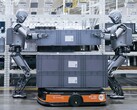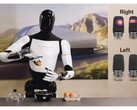We reported last week that XPeng’s Iron robot made a big splash with its almost-natural gait during a stage walk. The company's boss had to invite engineers to peel open the humanoid’s leg to convince the audience it was not an actor hired to play the part. XPeng has now released a follow-up video stripping the robot down to its metal skeleton, laying bare a system of actuators, servos, and wiring.
Dancing to demonstrate precision and flexibility
The new video, narrated by CEO He Xiaopeng, starts off with Iron executing a dance routine. Xiaopeng stated that dancing is a good method to demonstrate the robot’s motion precision and flexibility.
If you are impressed by Iron’s moves, the explanation is that it learned the classic way: by observing human dancers. The engineers fed it motion data using a large in-house AI model.
Xiaopeng claimed Iron learned the dance in just two hours, a drastic reduction from the two weeks it took when the engineers used reinforcement learning or trial-and-error.
The secret to Iron’s life-like walk
Iron’s ability to mimic human walking motion comes from the spine and waist design. The engineering of the spine allows the torso to be flexible, while the waist is designed to provide the rest of the body with balance, even while swaying, in imitation of human biomechanics. The precision control and mechanical resilience apparently are what enables Iron to retain its smooth walk even with some of its outer layers removed.
XPeng’s AI-powered robotics ambitions
XPeng hopes to see Iron deployed in many real-life scenarios, from factory floors to retail shops. The robot will be another outlet for the company’s AI-powered mobility efforts. However, XPeng is not alone in developing humanoids. Elon Musk’s Tesla revealed an Optimus robot in 2021 and has been releasing regular updates, and Samsung has teased its own version, too, after Toyota revealed a four-legged walking chair.



















